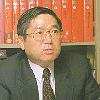- JST Home
- /
- Strategic Basic Research Programs
- /
 ERATO
ERATO- /
- Research Area/Projects/
- Completed/
- INOUE Superliquid Glass
INOUE Superliquid Glass

Research Director: Dr. Akihisa Inoue
(Director, Professor, Institute for Materials Research, Tohoku University)
Research Term: 1997-2002
The Inoue Supergliquid Glass project systematically studied the phenomenon of Superglass by 1) determining the utmost limits and mechanisms of the high thermal stability of metallic liquids; 2) studying the solidification behavior of a supercooled liquid into the glassy phase and the memorization of the structure and properties by the phase transition; and 3) examining the utmost limit of stabilization of a supercooled liquid.
Research Results
Atomic configuration in metal-metalloid type glassy alloys: Fe-based metallic glasses were investigated by an anomalous X-ray scattering method. It was found that the local atomic structures of Fe70M10B20 (M=Ta, Nb, Hf, Zr) metallic glasses are nearly the same as the random network of the trigonal prism-like structure of (Fe, M)-B with edge-sharing. At the same time, the atomic size mismatches between Fe and M becomes larger so that a rearrangement of the atoms for the transition from the glassy state to the crystalline state becomes very difficult. Furthermore, a new metastable phase of (Fe, M)23B6 was found at the first crystallization stage.
Atomic configuration in metal-metal type glassy alloys: In-situ observations of the structural change in Zr60Al15Ni25 metallic glass from the glass transition temperature to the supercooled liquid region were carried out by a newly developed (by this project) fast X-ray diffraction apparatus. It was shown that a rearrangement of the atomic configurations is difficult in Zr60Al15N25 glass with a highly dense random packed structure, and hence the supercooled liquid state becomes extraordinarily stable.
Prediction of glass composition ranges: The glass-forming composition ranges were predicted by applying Miedema’s semi-empirical method. The compositional dependence of the formation enthalpies of the amorphous (glass) phase and the solid solution phase was calculated. The agreement between the experimentally determined glass-forming composition range (GFR) and the calculated GFR was very good.
Highest glass-forming alloy: The local structure in the glassy state of Zr-based glassy alloys with high glass-forming ability was observed by a high-resolution transmission electron microscope technique. The icosahedral local structure was clarified in Zr-based glassy alloys. The result is in good agreement with the formation of the nano icosahedral phase in Zr-based glassy alloys. It is suggested that the glassy state is stabilized by the icosahedral local structure.
Nucleation and growth of a crystal in a supercooled liquid: In order to clarify the nucleation and growth behavior of the Pd-based undercooled melt, in-situ observations were carried out using a high-resolution transmission electron microscope and scanning laser microscope. Several kinds of solidified structures with different morphologies were observed at different temperatures. The structures were caused by different nucleation frequencies and growth rates.
New bulk glassy alloys: New Cu- and Ni-based bulk glassy alloys with high thermal stability were formed in metal-type systems, such as Cu- (Zr,Hf)-Ti and Ni-Nb-Ti(Zr,Hf) alloys. The supercooled liquid region and the reduced glass transition temperature are from 35 to 80 K and 0.59 to 0.63, respectively. Their maximum diameters are larger than 5 mm for Cu- and Ni-based alloys. These bulk glasses exhibit high tensile strength from 2000 to 2700 MPa.
Soft magnetic bulk glassy alloys: New Fe-based glassy alloys with a large supercooled liquid region in the (Fe, Co)-RE-B system were found. The Fe-based glassy alloys exhibited a high glass-forming ability and good soft magnetic properties. After a heat treatment, a nanocomposite structure consisting of hard magnetic and soft magnetic phases was obtained, and good hard magnetic properties were exhibited.

Feature of “Superliquid Glass”

An illustration of the high stability of supercooled liquid against crystallixation (stability increases as large as 106 ~ 108 times higher than conventional metallic liquid)

















